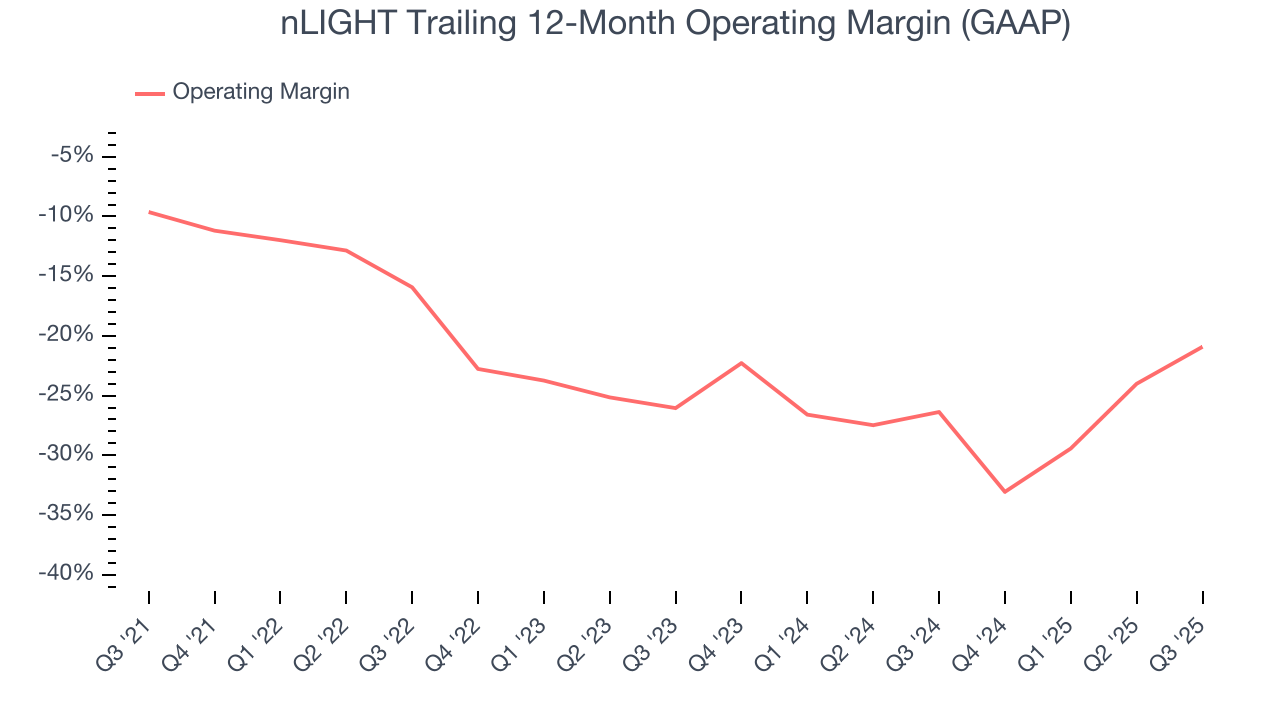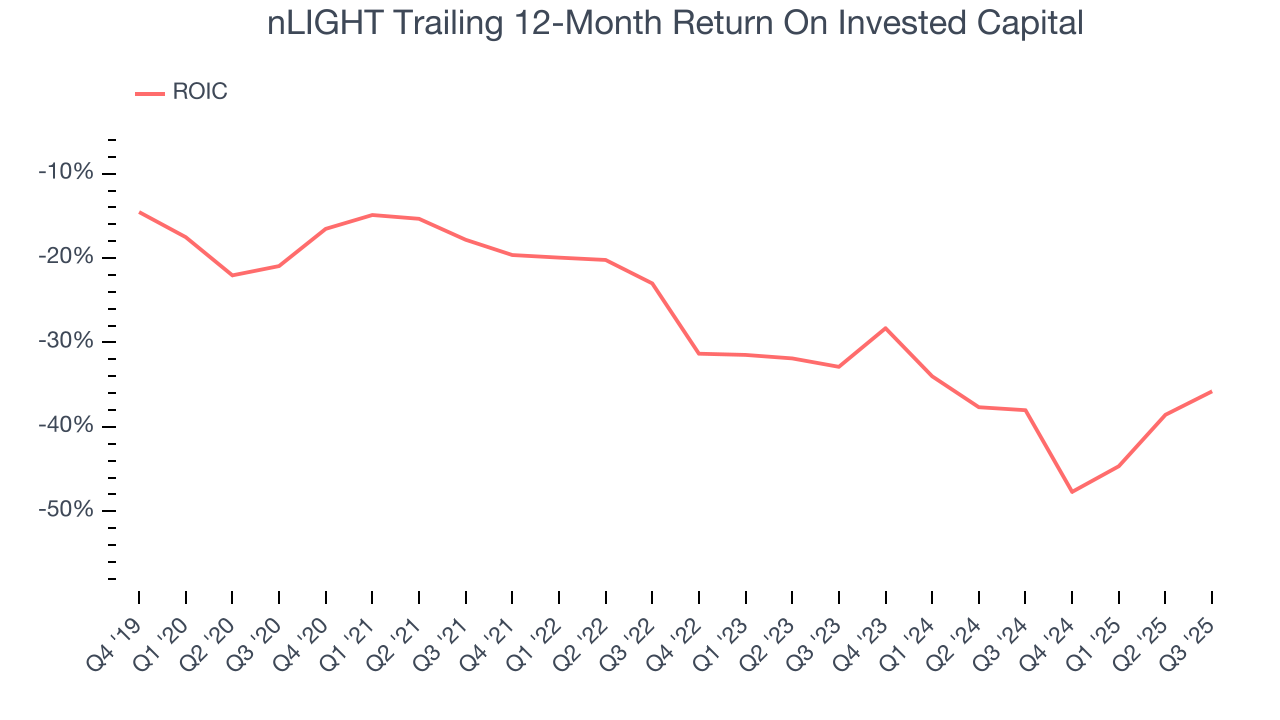
nLIGHT (LASR)
nLIGHT is in for a bumpy ride. Its poor sales growth shows demand is soft and its negative returns on capital suggest it destroyed value.― StockStory Analyst Team
1. News
2. Summary
Why We Think nLIGHT Will Underperform
Founded by a former CEO and Harvard-educated entrepreneur Scott Keeneyn, nLIGHT (NASDAQ:LASR) offers semiconductor and fiber lasers to the industrial, aerospace & defense, and medical sectors.
- Earnings per share fell by 58.5% annually over the last five years while its revenue grew, showing its incremental sales were much less profitable
- Historical operating margin losses have deepened over the last five years, hinting at increased competitive pressures and an inefficient cost structure
- Long-term business health is up for debate as its cash burn has increased over the last five years


nLIGHT doesn’t satisfy our quality benchmarks. Our attention is focused on better businesses.
Why There Are Better Opportunities Than nLIGHT
High Quality
Investable
Underperform
Why There Are Better Opportunities Than nLIGHT
nLIGHT is trading at $34.12 per share, or 126.9x forward P/E. This valuation is extremely expensive, especially for the weaker revenue growth you get.
We prefer to invest in similarly-priced but higher-quality companies with superior earnings growth.
3. nLIGHT (LASR) Research Report: Q3 CY2025 Update
Laser company nLIGHT (NASDAQ:LASR) reported Q3 CY2025 results topping the market’s revenue expectations, with sales up 18.9% year on year to $66.74 million. On top of that, next quarter’s revenue guidance ($75 million at the midpoint) was surprisingly good and 22.8% above what analysts were expecting. Its non-GAAP profit of $0.08 per share was significantly above analysts’ consensus estimates.
nLIGHT (LASR) Q3 CY2025 Highlights:
- Revenue: $66.74 million vs analyst estimates of $63.33 million (18.9% year-on-year growth, 5.4% beat)
- Adjusted EPS: $0.08 vs analyst estimates of $0.02 (significant beat)
- Adjusted EBITDA: $7.11 million vs analyst estimates of $3.30 million (10.7% margin, significant beat)
- Revenue Guidance for Q4 CY2025 is $75 million at the midpoint, above analyst estimates of $61.07 million
- EBITDA guidance for Q4 CY2025 is $8.5 million at the midpoint, above analyst estimates of $1.87 million
- Operating Margin: -10.9%, up from -21% in the same quarter last year
- Free Cash Flow Margin: 3.7%, down from 29.6% in the same quarter last year
- Market Capitalization: $1.57 billion
Company Overview
Founded by a former CEO and Harvard-educated entrepreneur Scott Keeneyn, nLIGHT (NASDAQ:LASR) offers semiconductor and fiber lasers to the industrial, aerospace & defense, and medical sectors.
nLIGHT was founded in 2000 with a vision to develop and commercialize lasers. M&A has historically been pivotal in facilitating its growth, such as the acquisition of Nutronics in 2018, which strengthened its position in the aerospace & defense sector.
Today, nLIGHT specializes in designing and manufacturing semiconductor and fiber lasers for the industrial, aerospace & defense, and medical sectors. The company’s semiconductor lasers serve as the backbone for numerous industrial processes and enable manufacturers to improve productivity and cost-effectiveness. In addition, it offers fiber lasers that excel in applications requiring ultra-fine control.
The primary revenue sources for nLIGHT ultimately come from the sale of its semiconductor and fiber laser products along with related accessories and services. The company engages in contracts with original equipment manufacturers (OEMs), integrators, and end-users that often involve customizations, volume commitments, and technical support agreements. Additionally, nLIGHT offers training programs and aftermarket services. Its ongoing maintenance contracts and service agreements serve as sources of recurring revenue for the company.
4. Electronic Components
Like many equipment and component manufacturers, electronic components companies are buoyed by secular trends such as connectivity and industrial automation. More specific pockets of strong demand include data centers and telecommunications, which can benefit companies whose optical and transceiver offerings fit those markets. But like the broader industrials sector, these companies are also at the whim of economic cycles. Consumer spending, for example, can greatly impact these companies’ volumes.
Competitors offering similar products include IPG Photonics (NASDAQ:IPGP), Coherent (NASDAQ:COHR), and Jenoptik AG (ETR:JEN).
5. Revenue Growth
A company’s long-term performance is an indicator of its overall quality. Any business can put up a good quarter or two, but the best consistently grow over the long haul. Unfortunately, nLIGHT’s 2.6% annualized revenue growth over the last five years was sluggish. This fell short of our benchmarks and is a rough starting point for our analysis.

Long-term growth is the most important, but within industrials, a half-decade historical view may miss new industry trends or demand cycles. nLIGHT’s annualized revenue growth of 2.9% over the last two years aligns with its five-year trend, suggesting its demand was consistently weak. 
We can dig further into the company’s revenue dynamics by analyzing its most important segments, Laser Products and Advanced Developments, which are 71.3% and 28.7% of revenue. Over the last two years, nLIGHT’s Laser Products revenue (lasers, amplifiers, and directed energy products) averaged 4.1% year-on-year declines. On the other hand, its Advanced Developments revenue (R&D contracts) averaged 19.1% growth. 
This quarter, nLIGHT reported year-on-year revenue growth of 18.9%, and its $66.74 million of revenue exceeded Wall Street’s estimates by 5.4%. Company management is currently guiding for a 58.3% year-on-year increase in sales next quarter.
Looking further ahead, sell-side analysts expect revenue to grow 9% over the next 12 months, an improvement versus the last two years. This projection is commendable and suggests its newer products and services will spur better top-line performance.
6. Gross Margin & Pricing Power
For industrials businesses, cost of sales is usually comprised of the direct labor, raw materials, and supplies needed to offer a product or service. These costs can be impacted by inflation and supply chain dynamics in the short term and a company’s purchasing power and scale over the long term.
nLIGHT has bad unit economics for an industrials company, giving it less room to reinvest and develop new offerings. As you can see below, it averaged a 24% gross margin over the last five years. Said differently, nLIGHT had to pay a chunky $76.00 to its suppliers for every $100 in revenue. 
In Q3, nLIGHT produced a 31.1% gross profit margin, up 8.7 percentage points year on year. nLIGHT’s full-year margin has also been trending up over the past 12 months, increasing by 3.3 percentage points. If this move continues, it could suggest better unit economics due to more leverage from its growing sales on the fixed portion of its cost of goods sold (such as manufacturing expenses).
7. Operating Margin
nLIGHT’s high expenses have contributed to an average operating margin of negative 19.1% over the last five years. Unprofitable industrials companies require extra attention because they could get caught swimming naked when the tide goes out. It’s hard to trust that the business can endure a full cycle.
Looking at the trend in its profitability, nLIGHT’s operating margin decreased by 11.3 percentage points over the last five years. This raises questions about the company’s expense base because its revenue growth should have given it leverage on its fixed costs, resulting in better economies of scale and profitability. nLIGHT’s performance was poor no matter how you look at it - it shows that costs were rising and it couldn’t pass them onto its customers.

nLIGHT’s operating margin was negative 10.9% this quarter. The company's consistent lack of profits raise a flag.
8. Earnings Per Share
Revenue trends explain a company’s historical growth, but the long-term change in earnings per share (EPS) points to the profitability of that growth – for example, a company could inflate its sales through excessive spending on advertising and promotions.
nLIGHT’s earnings losses deepened over the last five years as its EPS dropped 58.5% annually. We tend to steer our readers away from companies with falling EPS, where diminishing earnings could imply changing secular trends and preferences. If the tide turns unexpectedly, nLIGHT’s low margin of safety could leave its stock price susceptible to large downswings.

Like with revenue, we analyze EPS over a shorter period to see if we are missing a change in the business.
For nLIGHT, its two-year annual EPS growth of 31.8% was higher than its five-year trend. Its improving earnings is an encouraging data point, but a caveat is that its EPS is still in the red.
In Q3, nLIGHT reported adjusted EPS of $0.08, up from negative $0.08 in the same quarter last year. This print easily cleared analysts’ estimates, and shareholders should be content with the results. Over the next 12 months, Wall Street is optimistic. Analysts forecast nLIGHT’s full-year EPS of negative $0.20 will flip to positive $0.02.
9. Cash Is King
Free cash flow isn't a prominently featured metric in company financials and earnings releases, but we think it's telling because it accounts for all operating and capital expenses, making it tough to manipulate. Cash is king.
While nLIGHT posted positive free cash flow this quarter, the broader story hasn’t been so clean. nLIGHT’s demanding reinvestments have drained its resources over the last five years, putting it in a pinch and limiting its ability to return capital to investors. Its free cash flow margin averaged negative 6.5%, meaning it lit $6.50 of cash on fire for every $100 in revenue.
Taking a step back, we can see that nLIGHT’s margin dropped by 8.2 percentage points during that time. Almost any movement in the wrong direction is undesirable because it is already burning cash. If the trend continues, it could signal it’s in the middle of a big investment cycle.

nLIGHT’s free cash flow clocked in at $2.45 million in Q3, equivalent to a 3.7% margin. The company’s cash profitability regressed as it was 25.9 percentage points lower than in the same quarter last year, but it’s still above its five-year average. We wouldn’t read too much into this quarter’s decline because capital expenditures can be seasonal and companies often stockpile inventory in anticipation of higher demand, leading to short-term swings. Long-term trends carry greater meaning.
10. Return on Invested Capital (ROIC)
EPS and free cash flow tell us whether a company was profitable while growing its revenue. But was it capital-efficient? Enter ROIC, a metric showing how much operating profit a company generates relative to the money it has raised (debt and equity).
nLIGHT’s five-year average ROIC was negative 29.5%, meaning management lost money while trying to expand the business. Its returns were among the worst in the industrials sector.

We like to invest in businesses with high returns, but the trend in a company’s ROIC is what often surprises the market and moves the stock price. Unfortunately, nLIGHT’s ROIC has decreased significantly over the last few years. Paired with its already low returns, these declines suggest its profitable growth opportunities are few and far between.
11. Balance Sheet Assessment
Companies with more cash than debt have lower bankruptcy risk.

nLIGHT is a well-capitalized company with $116.1 million of cash and $31.31 million of debt on its balance sheet. This $84.8 million net cash position is 5.4% of its market cap and gives it the freedom to borrow money, return capital to shareholders, or invest in growth initiatives. Leverage is not an issue here.
12. Key Takeaways from nLIGHT’s Q3 Results
We were impressed by nLIGHT’s optimistic EBITDA guidance for next quarter, which blew past analysts’ expectations. We were also glad its revenue and EPS both outperformed Wall Street’s estimates. Zooming out, we think this quarter featured a lot of important positives. The stock traded up 15.9% to $34.44 immediately after reporting.
13. Is Now The Time To Buy nLIGHT?
Updated: December 4, 2025 at 9:33 PM EST
When considering an investment in nLIGHT, investors should account for its valuation and business qualities as well as what’s happened in the latest quarter.
We cheer for all companies making their customers lives easier, but in the case of nLIGHT, we’ll be cheering from the sidelines. First off, its revenue growth was weak over the last five years. And while its projected EPS for the next year implies the company’s fundamentals will improve, the downside is its diminishing returns show management's prior bets haven't worked out. On top of that, its relatively low ROIC suggests management has struggled to find compelling investment opportunities.
nLIGHT’s P/E ratio based on the next 12 months is 128.7x. This multiple tells us a lot of good news is priced in - we think other companies feature superior fundamentals at the moment.
Wall Street analysts have a consensus one-year price target of $41.50 on the company (compared to the current share price of $36.37).







